Chemical Characteristics and Distribution Prediction of Hydrocarbon Source Rocks in the Continental Lacustrine Basin of the Chang 7 Member in the Heshui Area of the Ordos Basin, China
Abstract
1. Introduction
2. Geology Setting
3. Materials and Methods
4. Results
4.1. Key Characteristics and Corresponding Logging Indicators of Hydrocarbon Source Rocks
Lithological Varieties and Mineralogical Features of Hydrocarbon Source Rocks
4.2. Chemical Properties of Hydrocarbon Source Rocks
4.2.1. Abundance of Organic Matter in Source Rocks
4.2.2. Types of Organic Matter in Source Rocks
Identification of Organic Matter Types through Kerogen Macerals
Identification of Organic Matter Types through Rock Pyrolysis Method
4.2.3. Thermal Maturation Traits of Hydrocarbon Source Rocks
4.3. Logging Appraisal Techniques for Hydrocarbon Source Rocks
4.3.1. Logging Responses of Source Rocks
Distribution Characteristics of Dark Mudstone
Distribution Characteristics of the Shale
4.3.2. Conventional ΔLogR Method Model
4.3.3. Calculation of TOC for Source Rocks of Changyanchang Formation 7
4.3.4. Spatial Distribution Characteristics of Organic Matter Abundance
5. Discussion
5.1. Comparative Assessment of Hydrocarbon Generation Potential: Source Rocks in the Chang 7 Member, Heshui Area, vs. Other Terrestrial Lacustrine Source Rocks
5.2. Relationship between Deepwater Fine Grain Lithofacies and Source Rock Development
6. Conclusions
- (1)
- Sedimentary facies, water depth, hypoxic environments, and lake currents are pivotal factors influencing the distribution of hydrocarbon source rocks. Shale predominantly forms in enclosed deep lake environments, while mudstone is prevalent in semi-deep lake, pro-delta, and coastal shallow lake settings. Shale exhibits dark and well-defined foliation structures, featuring lower detrital mineral content such as quartz and feldspar and significantly higher organic carbon content compared to mudstone. The average organic carbon content in shale is 10.63%, five times higher than that observed in mudstone. Efforts have been made to refine the language and minimize repetition. Thin-section observations reveal that organic matter in shale follows a continuous layered pattern, whereas in mudstone, it takes on a star-like dispersion or combines with mineral layers to form a flocculent distribution. Shale primarily possesses kerogen types I-II1, while mudstone is categorized as II.
- (2)
- The comparative analysis highlights the exceptional lacustrine source rock characteristics of the Chang 7 member in the Heshui area of the Ordos Basin, China, surpassing others in terms of hydrocarbon potential, organic content, and maturity. Insights gained from this comparative study not only provide valuable guidance for targeted exploration and resource assessment in the Ordos Basin but also serve as a valuable reference for regions assessing their lacustrine hydrocarbon source rock potential. In a comprehensive evaluation, the shale in the Heshui area of the Ordos Basin stands out with substantial thickness, extensive spatial distribution, and rich organic matter, indicating favorable hydrocarbon generation potential. Consequently, it is classified as a “very good” and “excellent” source rock, further emphasizing its promising role in the field of hydrocarbon exploration and development.
- (3)
- Given the substantial distinctions in lithology, organic matter content, and hydrocarbon generation potential between shale and mudstone, shale exhibits dark and well-defined foliation structures, lower detrital mineral content, higher clay mineral content, and significantly elevated organic carbon content. These characteristics suggest a superior potential for hydrocarbon generation. The distribution of organic-rich shale within the Ordos Basin is closely associated with deep lake environments, hypoxic conditions, and lake flow. Shale, enriched in organic matter, is pivotal in oil and gas exploration and development.
Author Contributions
Funding
Data Availability Statement
Conflicts of Interest
References
- Xiao, L.; Bi, L.; Yi, T.; Lei, Y.; Wei, Q. Pore Structure Characteristics and Influencing Factors of Tight Reservoirs Controlled by Different Provenance Systems: A Case Study of the Chang 7 Members in Heshui and Xin’anbian of the Ordos Basin. Energies 2023, 16, 3410. [Google Scholar] [CrossRef]
- Wei, Q.; Zhang, H.; Han, Y.; Guo, W.; Xiao, L. Microscopic Pore Structure Characteristics and Fluid Mobility in Tight Reservoirs: A Case Study of the Chang 7 Member in the Western Xin’anbian Area of the Ordos Basin, China. Minerals 2023, 13, 1063. [Google Scholar] [CrossRef]
- Liu, B.; Teng, J.; Mastalerz, M. Maceral Control on the Hydrocarbon Generation Potential of Lacustrine Shales: A Case Study of the Chang 7 Member of the Triassic Yanchang Formation, Ordos Basin, North China. Energies 2023, 16, 636. [Google Scholar] [CrossRef]
- Zhang, W.; Liang, X.P.; Li, P.; Liu, G.H. The Exquisite Comparison of Shale Mineralogical-Geochemical Characteristics between Chang 7 Member and Chang 9 Member in Yanchang Formation, Ordos Basi. Geofluids 2023, 2023, 5039604. [Google Scholar] [CrossRef]
- Li, C.; Chen, S.J.; Liao, J.B.; Hou, Y.T.; Yu, T.; Liu, G.L.; Xu, K.; Wu, X.T. Geochemical characteristics of the Chang 7 Member in the southwestern Ordos Basin, China: The influence of sedimentary environment on the organic matter enrichment. Palaeoworld 2023, 32, 429–441. [Google Scholar] [CrossRef]
- Kormos, S.; Sachsenhofer, R.F.; Bechtel, A.; Radovics, B.G.; Katalin Milota, K.; Schubert, F. Source rock potential, crude oil characteristics and oil-to-source rock correlation in a Central Paratethys sub-basin, the Hungarian Palaeogene Basin (Pannonian basin). Mar. Pet. Geol. 2021, 127, 104955. [Google Scholar] [CrossRef]
- Barham, A.; Ismail, M.S.; Hermana, M.; Zainal Abidin, N.S. Biomarker characteristics of Montney source rock, British Columbia, Canada. Heliyon 2021, 7, e08395. [Google Scholar] [CrossRef]
- Curiale, J.A.; Curtis, J.B. Organic geochemical applications to the exploration for source-rock reservoirs-A review. J. Unconv. Oil Gas. Resour. 2016, 13, 1–31. [Google Scholar] [CrossRef]
- Fu, J.H.; Li, S.X.; Xu, L.M.; Niu, X.B. Paleo-sedimentary environmental restoration and its significance of Chang 7 Member of Triassic Yanchang Formation in Ordos Basin, NW China. Petrol. Explor. Develop. 2018, 45, 998–1008. [Google Scholar] [CrossRef]
- El-Khadragy, A.A.; Shazly, T.F.; Mousa, D.A.; Ramadan, M.; El-Sawy, M.Z. Integration of well log analysis data with geochemical data to evaluate possible source rock. Case study from GM-ALEF-1 well, Ras Ghara oil Field, Gulf of Suez-Egypt. Egypt. J. Pet. 2018, 27, 911–918. [Google Scholar] [CrossRef]
- Rahmani, O.; Khoshnoodkia, M.; Kadkhodaie, A.; Pour, A.B.; Tsegab, H. Geochemical Analysis for Determining Total Organic Carbon Content Based on ∆LogR Technique in the South Pars Field. Minerals 2019, 9, 735. [Google Scholar] [CrossRef]
- Fu, J.; Li, X.S.; Sun, Y.H.; Huo, Q.L.; Gao, T.; Fu, L.; Liu, Y.C.; Dong, S.X.; Fan, H.J. A New Evaluation Method of Total Organic Carbon for Shale Source Rock Based on the Effective Medium Conductivity Theory. Geofluids 2021, 9030311. [Google Scholar] [CrossRef]
- Zhang, W.Z.; Yang, H.; Li, S.P. Hydrocarbon accumulation significance of Chang 91 high-quality lacustrine source rocks of Yanchang Formation, Ordos Basin. Pet. Explor. Dev. 2008, 35, 557–562. [Google Scholar] [CrossRef]
- Hu, S.Q.; Zhang, H.W.; Zhang, R.J.; Jin, L.X.; Liu, Y.M. Quantitative Interpretation of TOC in Complicated Lithology Based on Well Log Data: A Case of Majiagou Formation in the Eastern Ordos Basin, China. Appl. Sci. 2021, 11, 8724. [Google Scholar] [CrossRef]
- Zhu, L.Q.; Zhang, C.; Zhang, C.M.; Zhang, Z.S.; Zhou, X.Q.; Liu, W.N.; Zhu, B.Y. A new and reliable dual model- and data-driven TOC prediction concept: A TOC logging evaluation method using multiple overlapping methods integrated with semi-supervised deep learning. J. Pet. Sci. Eng. 2020, 188, 106944. [Google Scholar] [CrossRef]
- Tissot, B.P.; Welte, D.H. Petroleum Formation and Occurrence; Springer: Berlin/Heidelberg, Germany, 1978. [Google Scholar] [CrossRef]
- Fu, S.Y.; Liao, Z.W.; Chen, A.Q.; Chen, H.D. Reservoir characteristics andmulti-stage hydrocarbonaccumulation of the UpperTriassic Yanchang Formationin the southwestern OrdosBasin, NW China. Nergy Explor. Exploit. 2020, 38, 348–371. [Google Scholar] [CrossRef]
- Wang, S.; Li, H.; Lin, L.; Yin, S. Development Characteristics and Finite Element Simulation of Fractures in Tight Oil Sandstone Reservoirs of Yanchang Formation in Western Ordos Basin. Front. Earth 2022, 9, 823855. [Google Scholar] [CrossRef]
- Kang, Y.; Ning, Z.F.; Lyu, F.T.; Jia, Z.J. Nanoscale profiling of the relationship between in-situ organic matter roughness, adhesion, and wettability under ScCO2 based on contact mechanics. Fuel 2024, 362, 130833. [Google Scholar] [CrossRef]
- Jiang, S.L.; Zhou, Q.H.; Li, Y.J.; Yang, R.L. A Case Study on Preservation Conditions and Influencing Factors of Shale Gas in the Lower Paleozoic Niutitang Formation, Western Hubei and Hunan, Middle Yangtze Region, China. Geofluids 2024, 2024, 6637899. [Google Scholar] [CrossRef]
- Shi, X.W.; Wu, W.; Wu, Q.Z.; Zhong, K.S.; Jiang, Z.X.; Miao, H. Controlling Factors and Forming Types of Deep Shale Gas Enrichment in Sichuan Basin, China. Energies 2022, 15, 7023. [Google Scholar] [CrossRef]
- Tian, T.; Zhou, S.X.; Fu, D.L.; Yang, F.; Li, J. Calculation of the original abundance of organic matter at high-over maturity: A case study of the Lower Cambrian Niutitang shale in the Micangshan-Hannan Uplift, SW China. J. Pet. Sci. 2019, 179, 645–654. [Google Scholar] [CrossRef]
- Astel, A.M.; Bigus, K.; Stec, M. Microbial enzymatic activity and its relation to organic matter abundance on sheltered and exposed beaches on the Polish coast. Oceanologia 2018, 60, 312–330. [Google Scholar] [CrossRef]
- Peters, K.E.; Cassa, M.R. Applied source rock geochemistry. AAPG Memoir 1994, 60, 93–102. [Google Scholar]
- Nel, H.A.; Dalu, T.; Wasserman, R.J. Sinks and sources: Assessing microplastic abundance in river sediment and deposit feeders in an Austral temperate urban river system. Sci. Total Environ. 2018, 612, 950–956. [Google Scholar] [CrossRef] [PubMed]
- International Committee for Coal Petrology (ICCP). International Handbook of Coal Petrography, 2nd ed.; Centre National de la Recherche Scientifique: Paris, France; Academy of Sciences of the USSR: Moscow, Russia, 1963. [Google Scholar]
- International Committee for Coal Petrology, (ICCP). International Handbook of Coal Petrography; 1st Supplement to 2nd Edition; CNRS: Paris, France, 1971. [Google Scholar]
- International Committee for Coal Petrology, (ICCP). International Handbook of Coal Petrography; 2nd Supplement to 2nd Edition; CNRS: Paris, France, 1975. [Google Scholar]
- International Committee for Coal Petrology, (ICCP). International Handbook of Coal Petrography; 3rd Supplement to 2nd Edition; University of Newcastle on Tyne: Newcastle upon Tyne, UK, 1993. [Google Scholar]
- International Committee for Coal and Organic Petrology, (ICCP). The new vitrinite classification (ICCP System 1994). Fuel 1998, 77, 349–358. [Google Scholar] [CrossRef]
- International Committee for Coal and Organic Petrology (ICCP). The new inertinite classification (ICCP System 1994). Fuel 2001, 80, 459–471. [Google Scholar] [CrossRef]
- Sýkorová, I.; Pickel, W.; Christianis, K.; Wolf, M.; Taylor, G.H.; Flores, D. Classification of huminite—ICCP System 1994. Int. J. Coal Geol. 2005, 62, 85–106. [Google Scholar] [CrossRef]
- Fathy, D.; Baniasad, A.; Littke, R.; Sami, M. Tracing the geochemical imprints of Maastrichtian black shales in southern Tethys, Egypt: Assessing hydrocarbon source potential and environmental signatures. Int. J. Coal Geol. 2024, 283, 104457. [Google Scholar] [CrossRef]
- Labus, M.; Matyasik, I. Application of different thermal analysis techniques for the evaluation of petroleum source rocks. J. Therm. Anal. Calorim. 2019, 136, 1185–1194. [Google Scholar] [CrossRef]
- Tissot, B.P.; Welte, D.H. Petroleum Formation and Occurrence, 2nd ed.; Springer: Berlin/Heidelberg, Germany; New York, NY, USA, 1985; Volume 40, pp. 563–579. [Google Scholar]
- Hu, D.; Rao, S.; Wang, Z.T.; Hu, S.B. Thermal and maturation history for Carboniferous source rocks in the Junggar Basin, Northwest China: Implications for hydrocarbon exploration. Pet. Sci. 2020, 17, 36–50. [Google Scholar] [CrossRef]
- Xiao, Z.L.; Chen, S.J.; Zhao, R.Q.; Han, M.M. Total organic carbon logging evaluation of Fengcheng source rock in the western Mahu Sag, Junggar Basin, China. Energy Sources Part. A Recovery Util. Environ. Eff. 2021. [Google Scholar] [CrossRef]
- Bakhtiar, H.A.; Telmadarreie, A.; Shayesteh, M.; Heidari Fard, M.H.; Talebi, H.; Shirband, Z. Estimating Total Organic Carbon Content and Source Rock Evaluation, Applying ΔlogR and Neural Network Methods: Ahwaz and Marun Oilfields, SW of Iran. Pet. Sci. Technol. 2013, 29, 1691–1704. [Google Scholar] [CrossRef]
- Tenaglia, M.; Eberli, G.P.; Weger, R.J.; Blanco, L.R.; Rueda Sanchez, L.E.; Swart, P.K. Total organic carbon quantification from wireline logging techniques: A case study in the Vaca Muerta Formation, Argentina. J. Pet. Sci. Eng. 2020, 194, 107489. [Google Scholar] [CrossRef]
- Aziz, H.; Ehsan, M.; Ali, A.; Khan, H.K.; Khan, A. Hydrocarbon source rock evaluation and quantification of organic richness from correlation of well logs and geochemical data: A case study from the sembar formation, Southern Indus Basin, Pakistan. J. Nat. Gas. Sci. Eng. 2020, 81, 103433. [Google Scholar] [CrossRef]
- Alizadeh, B.; Maroufi, K.; Heidarifard, M.H. Estimating source rock parameters using wireline data: An example from Dezful Embayment, South West of Iran. J. Pet. Sci. Eng. 2018, 167, 857–868. [Google Scholar] [CrossRef]
- Wang, J.X.; Sun, P.C.; Liu, Z.J.; Xu, Y.B.; Li, L. Evaluation of oil shale resources based on geochemistry and logging in Tuanyushan, Qaidam Basin, Northwest China. Oil Shale 2020, 37, 188–206. [Google Scholar] [CrossRef]
- Kamalia, M.R.; Mirshady, A.A. Total organic carbon content determined from well logs using DLogR and Neuro Fuzzy techniques. J. Pet. Sci. Eng. 2004, 45, 141–148. [Google Scholar] [CrossRef]
- Zhu, G.Y.; Jin, Q.; Zhang, L.H. Using Log Information to Analyze the Geochemical Characteristics of Source Rocks in Jiyang Depression. WLT. Logging Technol. 2003, 27, 104–109. [Google Scholar] [CrossRef]
- Powell, T.G. Petroleum geochemistry and depositional setting of lacustrine source rocks. Mar. Pet. Geol. 1986, 3, 200–219. [Google Scholar] [CrossRef]
- Zhao, Q.Z.; Zhang, B.; Wang, X.M.; Wu, S.T.; Zhang, S.C.; Liu, W.; Wang, K.; Zhao, X. Differences in source kitchens for lacustrine in-source and out-of-source hydrocarbon accumulations. Petrol. Explor. Develop. 2021, 48, 541–554. [Google Scholar] [CrossRef]
- Chen, Z.; Li, X.; Chen, H.; Duan, Z.; Qiu, Z.; Zhou, X.; Hou, Y. The Characteristics of Lithofacies and Depositional Model of Fine-Grained Sedimentary Rocks in the Ordos Basin, China. Energies 2023, 16, 2390. [Google Scholar] [CrossRef]
- Wu, H.G.; Feng, C.C.; Kang, X.; Fu, D.W.; Feng, J.L.; Zhang, Y.F.; Zhou, J.J.; Hu, T.X. Positive and negative effects of marine transgression on the quality of lacustrine source rocks in the Upper Cretaceous Songliao Basin, China. Mar. Pet. Geol. 2023, 153, 106267. [Google Scholar] [CrossRef]
- Nytoft, H.P.; WesselFyhn, M.B.; Hovikoski, J.; Rizzi, M.; Abatzis, I.; Tuan, H.A.; Tung, N.T.; Huyen, N.T.; Cuong, T.X.; Nielsen, L.H. Biomarke-rs of Oligocene lacustrine source rocks, Beibuwan-Song Hong basin junction, offshore northern Vietnam. Mar. Pet. Geol. 2020, 114, 104196. [Google Scholar] [CrossRef]
- Ajuaba, S.; Sachsenhofer, R.F.; Meier, V.; Gross, D.; Schnyder, J.; Omodeo-Sal, S.; Moscariello, A.; Misch, D. Coaly and lacustrine hydrocarbon source rocks in Permo-Carboniferous graben deposits (Weiach well, Northern Switzerland). Mar. Pet. Geol. 2023, 150, 106147. [Google Scholar] [CrossRef]
- Harris, N.B.; Freeman, K.H.; Pancost, R.D.; White, T.S.; Mitchell, G.D. The character and origin of lacustrine source rocks in the Lower Cretaceous synrift section, Congo Basin, west Africa. AAPG Bull. 2004, 88, 1118–1163. [Google Scholar] [CrossRef]
- Parnell, J. Lacustrine petroleum source rocks in the Dinantian Oil Shale Group, Scotland: A review. Geol. Soc. Lond. Spec. Publ. 1988, 40, 235–246. [Google Scholar] [CrossRef]
- Röth, J.; Baniasad, A.; Froidl, F.; Ostlender, J.; Boreham, C.; Hall, L.; Littke, R.; Baniasad, A.; Froidl, F.; Ostlender, J.; et al. The Birkhead and Murta formations—Organic geochemistry and organic petrography of Mesozoic fuvio-lacustrine source rocks in the Eromanga Basin, central Australia. Int. J. Earth Sci. 2023, 112, 265–295. [Google Scholar] [CrossRef]
- Rddad, L. Hydrocarbon Potential of the Triassic Lacustrine Source Rocks in the Newark Basin, USA. J. Energy Environ. Chem. Eng. 2019, 4, 47–53. [Google Scholar] [CrossRef]
- Liu, L.; Pan, H.P.; Lin, Z.Z.; Zhang, S.H.; Qin, Z.; Li, J.W.; Huang, G.S.; Wang, L.; Li, D. Reservoir characteristics and logging evaluation of gas−bearing mudstone in the south of north china plain. Sci. Rep. 2020, 10, 8791. [Google Scholar] [CrossRef]
- Hart, B.S.; Acquaker, J.H.S.; Taylor, K.G. Mudstone (“shale”) depositional and diagenetic processes: Implications for seismic analyses of source-rock reservoirs. Interpretation 2013, 1, 7–26. [Google Scholar] [CrossRef]
- Zhao, L.; Li, Y.; Zou, C.; Zhao, S.; Wu, C. Paleoenvironmental characteristics and organic matter enrichment mechanisms of the upper Ordovician-lower Silurian organic-rich black shales in the Yangtze foreland basin, South China. Front. Earth 2023, 11, 1237495. [Google Scholar] [CrossRef]
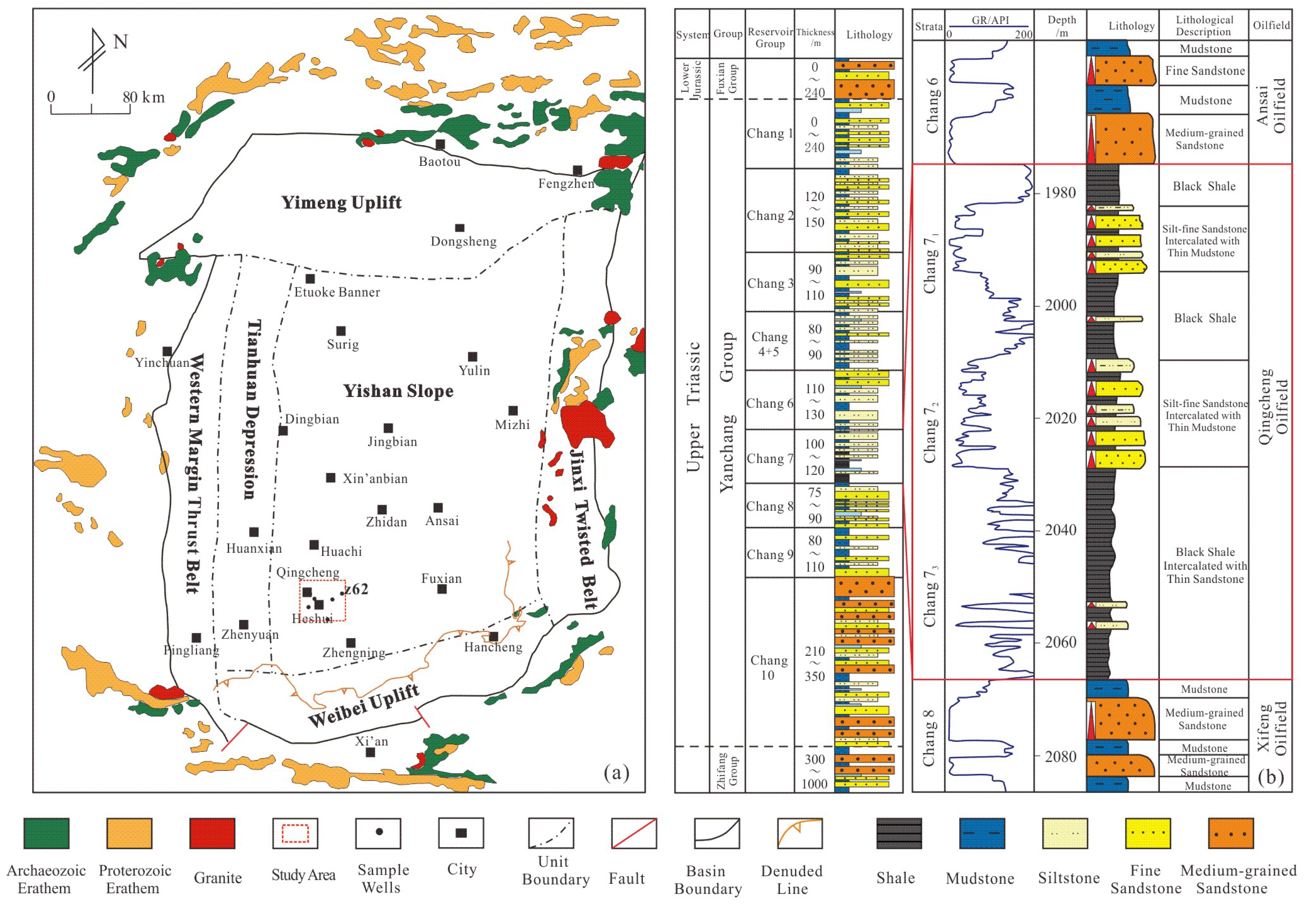

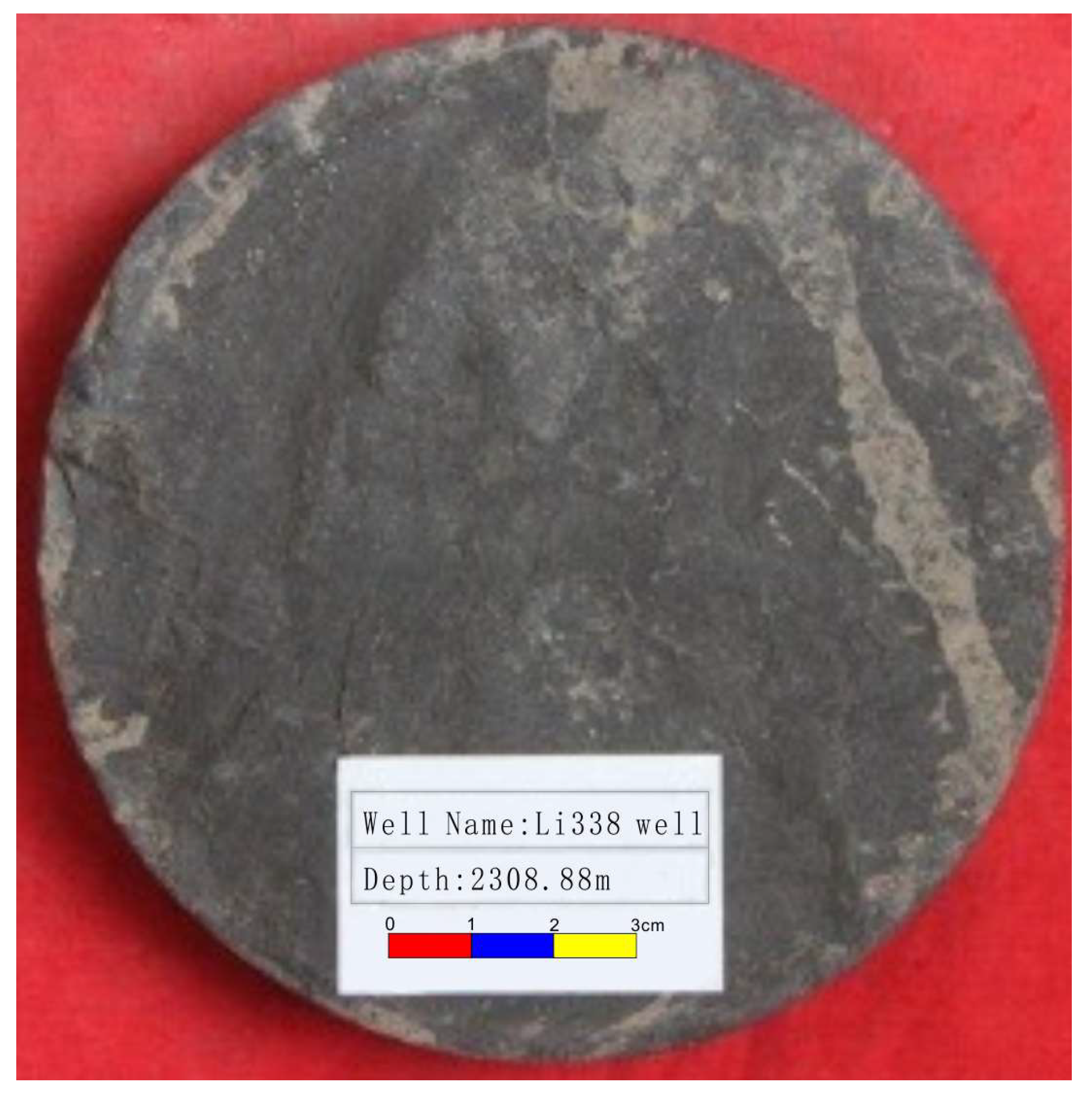



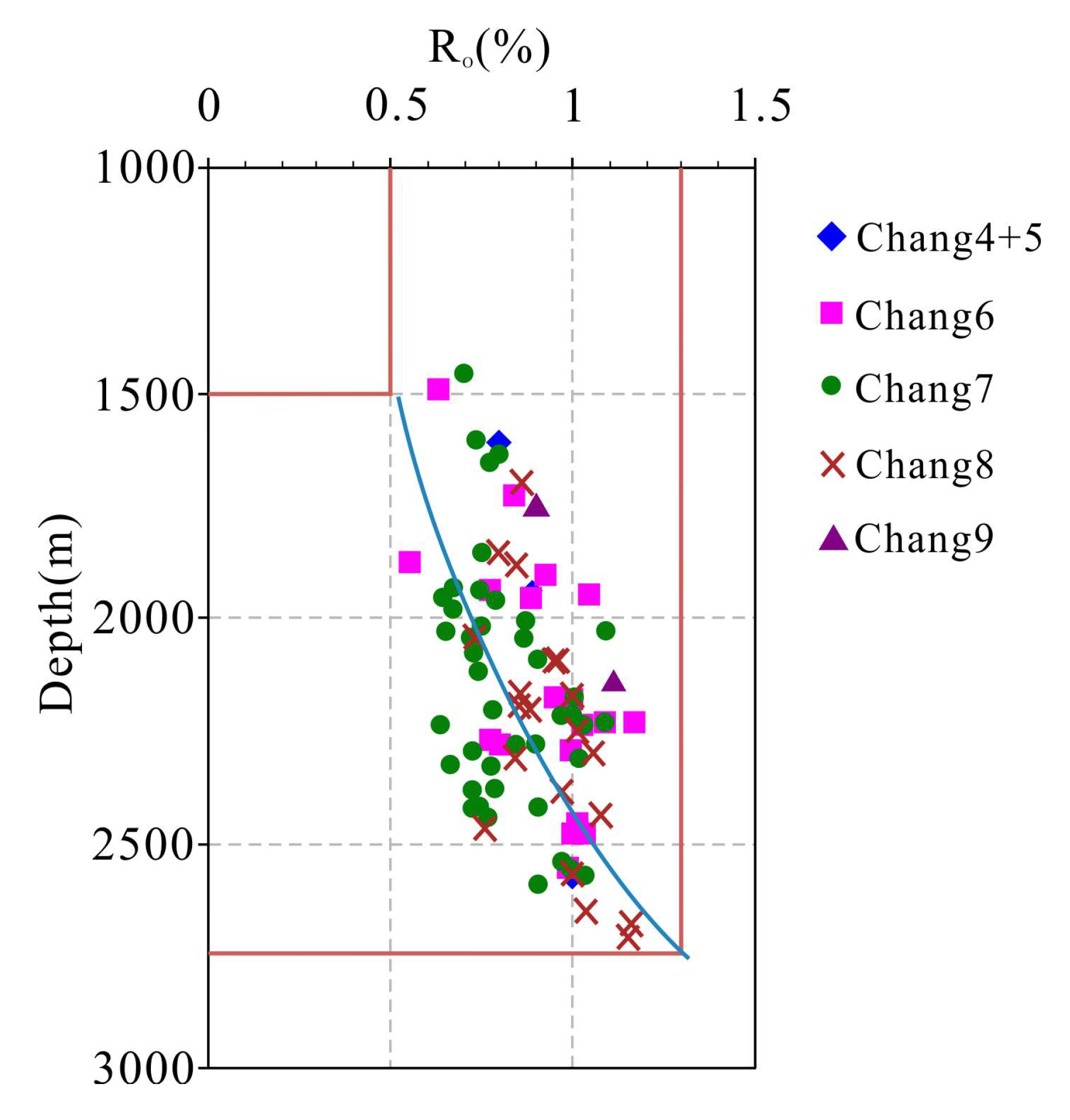



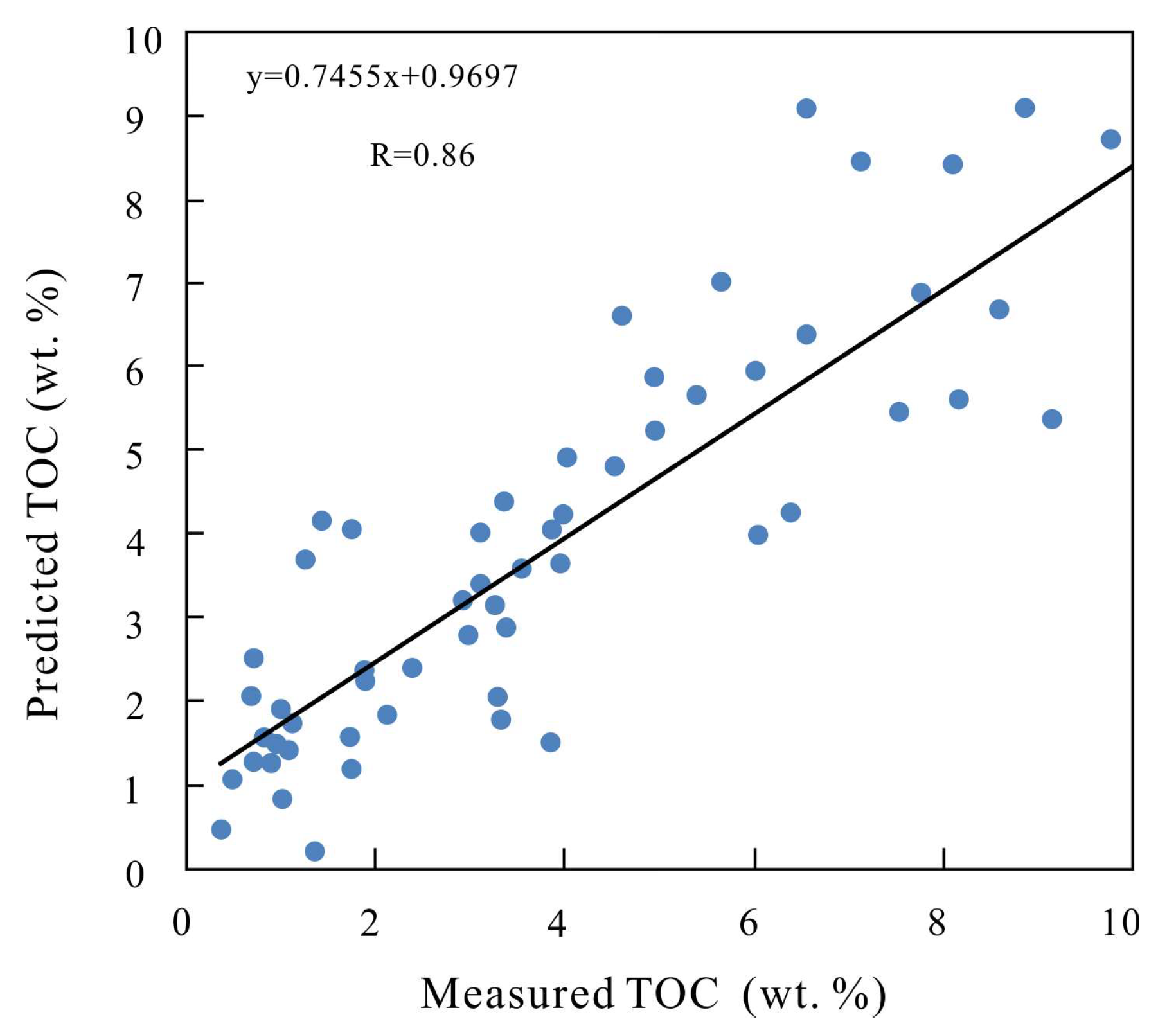



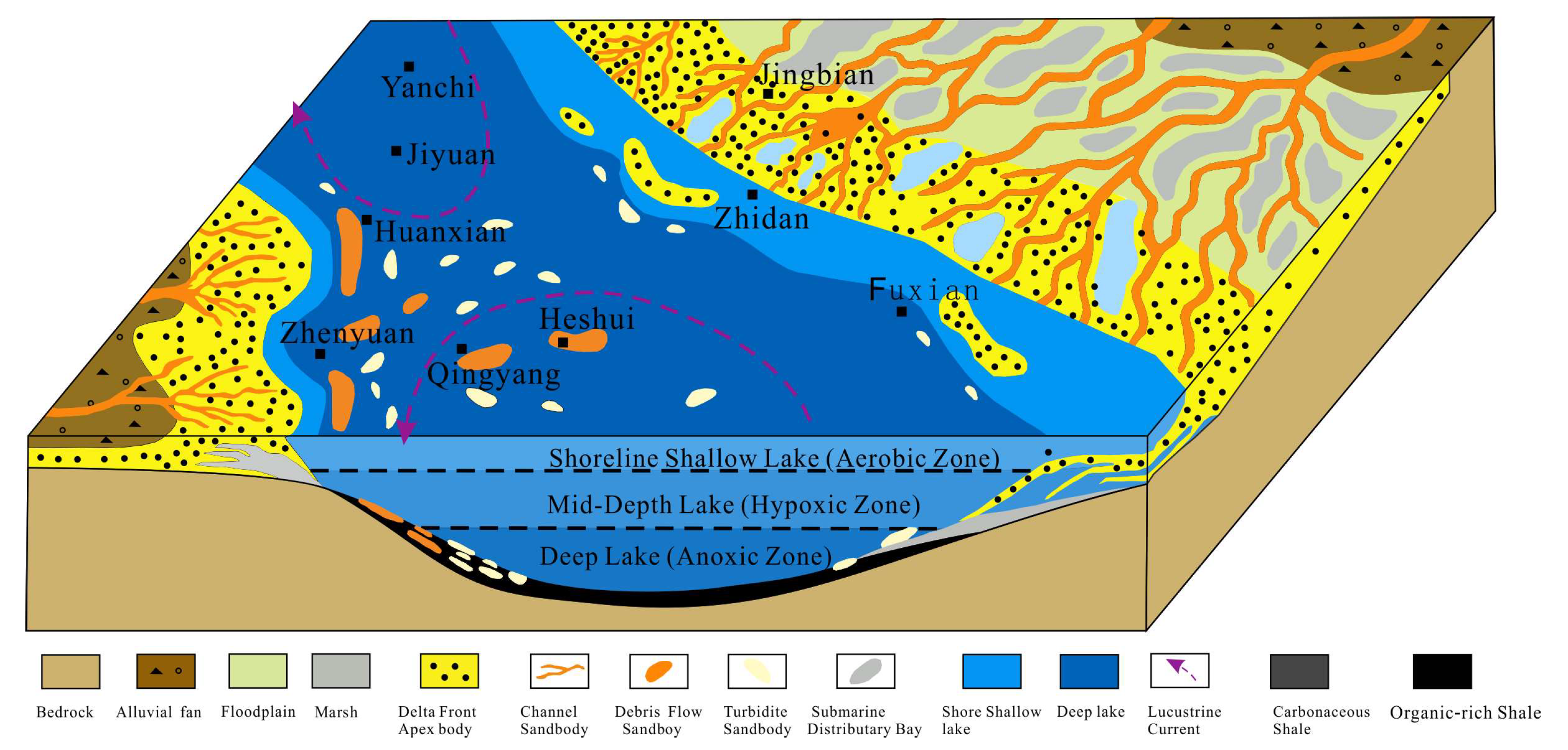
| Index | Source Rock | |||||
|---|---|---|---|---|---|---|
| Poor | Fair | Good | Very Good | Excellent | ||
| TOC (wt.%) | <0.5 | 0.5–1.0 | 1.0–2.0 | 2.0–4.0 | >4.0 | |
| Rock-Eval Pyrolysis | S1 (mg HC/g rock) | 0–0.5 | 0.5–1 | 1–2 | 2–4 | >4 |
| S2 (mg HC/g rock) | 0–2.5 | 2.5–5 | 5–10 | 10–20 | >20 | |
| Sample | Depth(m) | Lithology | a (%) | b (%) | c (%) | d (%) | KTI | Organic Matter Type |
|---|---|---|---|---|---|---|---|---|
| X36-1 | 2175.0 | Shale | 90.4 | 0.8 | 6.6 | 2.2 | 83.7 | I |
| X36-2 | 2175.4 | Shale | 98.4 | 0 | 1.6 | 0 | 97.2 | I |
| Z233 | 1785.9 | Shale | 7.0 | 68.0 | 18.0 | 7.0 | 21.0 | II2 |
| Z89 | 1956.9 | Shale | 7.0 | 59.0 | 21.0 | 13.0 | 8.0 | II2 |
| M34 | 2295.0 | Mudstone | 87.8 | 1.4 | 10.0 | 0.8 | 80.2 | II1 |
| L338-1 | 2269.6 | Mudstone | 35.0 | 56.0 | 4.0 | 5.0 | 55.0 | II1 |
| L338-2 | 2308.1 | Mudstone | 37.0 | 52.0 | 5.0 | 6.0 | 53.0 | II1 |
| L338-3 | 2324.1 | Mudstone | 15.0 | 63.0 | 17.0 | 5.0 | 29.0 | II2 |
| L304 | 2495.2 | Mudstone | 9.0 | 52.0 | 18.0 | 21.0 | 1.0 | II2 |
| N105 | 1527.7 | Mudstone | 9.0 | 58.0 | 23.0 | 10.0 | 11.0 | II2 |
| N33 | 1655.4 | Mudstone | 30.0 | 58.0 | 9.0 | 3.0 | 49.0 | II1 |
| X288 | 2116.3 | Mudstone | 57.0 | 36.0 | 6.0 | 1.0 | 70.0 | II1 |
| X291 | 1982.2 | Mudstone | 19.0 | 65.0 | 12.0 | 4.0 | 39.0 | II2 |
| X318 | 2026.9 | Mudstone | 10.0 | 67.0 | 18.0 | 5.0 | 25.0 | II2 |
| Sample | Depth (m) | Lithology | Tmax (°C) | S1 (mg HC/g) | S2 (mg HC/g) | S3 (mg CO2/g rock) | TOC (wt %) | HI (mg HC/g org C) | OI (mg CO2/g org C) |
|---|---|---|---|---|---|---|---|---|---|
| D49-1 | 1533.2 | Mudstone | 448 | 1.65 | 6.67 | 0.02 | 3.24 | 205.86 | 0.62 |
| D49-2 | 1533.6 | Mudstone | 451 | 2.02 | 10.02 | 0.06 | 3.95 | 253.67 | 1.52 |
| D49-3 | 1534.1 | Mudstone | 446 | 3.91 | 17.10 | 0.13 | 3.37 | 507.42 | 3.86 |
| D49-4 | 1534.5 | Mudstone | 441 | 1.95 | 0.07 | 0.00 | 3.18 | 220.13 | 2.2 |
| D49-5 | 1535.1 | Mudstone | 445 | 1.64 | 7.22 | 0.09 | 3.07 | 235.18 | 2.93 |
| D49-6 | 1535.5 | Mudstone | 439 | 2.16 | 7.65 | 0.14 | 3.23 | 236.84 | 4.33 |
| D49-7 | 1535.7 | Mudstone | 446 | 1.93 | 8.75 | 0.16 | 3.12 | 280.45 | 5.13 |
| D49-8 | 1536.8 | Mudstone | 449 | 2.18 | 9.91 | 0.09 | 3.64 | 272.25 | 2.47 |
| D49-9 | 1537.1 | Mudstone | 451 | 2.76 | 9.99 | 0.02 | 4.54 | 220.04 | 0.44 |
| H158 | 2117.4 | Mudstone | 448 | 1.37 | 9.38 | 0.21 | 3.65 | 256.99 | 5.75 |
| M14-1 | 2120.8 | Shale | 447 | 1.44 | 12.88 | 0.00 | 4.39 | 293.39 | 0 |
| M14-2 | 2120.8 | Shale | 448 | 1.49 | 12.71 | 0.93 | 4.44 | 286.26 | 20.95 |
| M14-3 | 2122.2 | Shale | 449 | 2.27 | 48.13 | 0.00 | 11.61 | 414.56 | 0 |
| M14-4 | 2122.2 | Shale | 449 | 2.27 | 48.13 | 0.00 | 11.61 | 414.56 | 0 |
| M14-5 | 2123.3 | Shale | 446 | 2.33 | 40.43 | 0.05 | 10.15 | 298.33 | 0.49 |
| M14-6 | 2123.3 | Shale | 447 | 3.83 | 82.31 | 1.31 | 19.38 | 424.72 | 6.76 |
| M14-7 | 2124.4 | Shale | 447 | 2.60 | 45.80 | 0.72 | 10.98 | 417.12 | 6.56 |
| M14-8 | 2124.4 | Shale | 447 | 2.60 | 45.80 | 0.72 | 10.98 | 417.12 | 6.56 |
| X36-1 | 2175.0 | Shale | 454 | 3.56 | 18.67 | 0.27 | 5.21 | 358.35 | 5.18 |
| X36-2 | 2175.4 | Shale | 452 | 4.34 | 18.86 | 0.16 | 5.49 | 343.53 | 2.91 |
| L57 | 2246.0 | Shale | 447 | 3.60 | 27.20 | 0.05 | 15.3 | 177.78 | 0.33 |
| M34 | 2295.0 | Mudstone | 442 | 2.15 | 8.15 | 0.30 | 3.54 | 230.23 | 8.47 |
| L38-1 | 2324.6 | Mudstone | 447 | 0.61 | 6.73 | 0.47 | 2.87 | 234.49 | 16.38 |
| L38-2 | 2325.0 | Shale | 446 | 3.24 | 71.63 | 0.51 | 20.5 | 349.41 | 2.49 |
| L38-3 | 2326.0 | Shale | 438 | 1.52 | 15.41 | 0.47 | 5 | 308.2 | 9.4 |
| L38-4 | 2326.5 | Shale | 446 | 1.28 | 13.34 | 0.41 | 4.34 | 307.37 | 9.45 |
| L38-5 | 2327.5 | Shale | 434 | 1.54 | 13.27 | 0.30 | 4.4 | 301.59 | 6.82 |
| L38-6 | 2328.0 | Shale | 444 | 2.49 | 45.42 | 0.42 | 13.4 | 338.96 | 3.13 |
| L38-7 | 2328.8 | Shale | 446 | 2.73 | 70.89 | 0.34 | 19.1 | 371.15 | 1.78 |
| L38-8 | 2329.1 | Shale | 446 | 2.46 | 62.08 | 0.41 | 17.4 | 356.78 | 2.36 |
| L38-9 | 2329.5 | Shale | 446 | 3.13 | 86.08 | 0.65 | 22.14 | 388.8 | 2.94 |
| L38-10 | 2330.2 | Shale | 422 | 4.27 | 8.74 | 0.24 | 3.75 | 233.07 | 6.4 |
| L38-11 | 2331.0 | Shale | 442 | 3.72 | 60.69 | 0.47 | 20.9 | 290.38 | 2.25 |
| L38-12 | 2331.4 | Shale | 442 | 4.33 | 80.89 | 0.55 | 24.86 | 325.38 | 2.21 |
| L38-13 | 2332.0 | Shale | 441 | 4.39 | 93.07 | 0.80 | 24.18 | 384.9 | 3.31 |
| L57-1 | 2348.8 | Shale | 445 | 4.04 | 39.69 | 0.00 | 14.02 | 283.1 | 0 |
| L57-2 | 2349.1 | Shale | 445 | 5.76 | 66.97 | 0.00 | 13.91 | 481.45 | 0 |
| L57-3 | 2349.5 | Shale | 440 | 7.56 | 68.20 | 0.04 | 21.37 | 319.14 | 0.19 |
| L57-4 | 2350.1 | Shale | 445 | 4.36 | 51.16 | 0.00 | 26.18 | 195.42 | 0 |
| L57-5 | 2351.1 | Shale | 443 | 5.65 | 93.00 | 0.03 | 15.3 | 607.84 | 0.2 |
| L57-6 | 2353.0 | Shale | 448 | 2.59 | 39.37 | 0.15 | 26.63 | 147.84 | 0.56 |
| L57-7 | 2353.3 | Shale | 447 | 2.17 | 38.17 | 0.04 | 11.01 | 346.68 | 0.36 |
| L57-8 | 2353.8 | Shale | 449 | 3.19 | 53.46 | 0.00 | 10.68 | 500.56 | 0 |
| M13-1 | 2488.7 | Mudstone | 442 | 4.60 | 16.32 | 0.00 | 4.87 | 335.11 | 0 |
| M13-2 | 2488.7 | Mudstone | 443 | 5.56 | 17.29 | 1.10 | 5.29 | 326.84 | 20.79 |
| M13-3 | 2489.7 | Mudstone | 442 | 3.45 | 9.83 | 0.54 | 3.13 | 314.06 | 17.25 |
| M13-4 | 2489.7 | Mudstone | 442 | 3.45 | 9.83 | 0.54 | 3.13 | 314.06 | 17.25 |
| M13-5 | 2490.7 | Mudstone | 445 | 4.94 | 17.81 | 0.00 | 4.69 | 379.74 | 0 |
| M13-6 | 2490.7 | Mudstone | 442 | 3.84 | 10.90 | 0.59 | 3.3 | 330.3 | 17.88 |
| M13-7 | 2491.7 | Mudstone | 443 | 4.11 | 12.08 | 0.63 | 3.45 | 350.14 | 18.26 |
| M13-8 | 2491.7 | Mudstone | 443 | 4.11 | 12.08 | 0.63 | 3.45 | 350.14 | 18.26 |
| M13-9 | 2492.7 | Mudstone | 446 | 5.59 | 19.03 | 0.90 | 5.72 | 332.69 | 15.73 |
| M13-10 | 2492.7 | Mudstone | 446 | 5.59 | 19.03 | 0.90 | 5.72 | 332.69 | 15.73 |
| M13-11 | 2493.5 | Mudstone | 434 | 4.87 | 11.49 | 0.76 | 3.5 | 328.29 | 21.71 |
| C96 | 2614.9 | Mudstone | 400 | 1.71 | 2.38 | 0.11 | 1.09 | 218.35 | 10.09 |
| Evolution Stage | Ro/% | Tmax/°C |
|---|---|---|
| Immature | 0.2–0.6 | <435 |
| Early mature | 0.6~0.65 | 435~445 |
| Peak mature | 0.65~0.9 | 445~450 |
| Late Mature | 0.9~1.35 | 450~470 |
| Postmature | >1.35 | >470 |
| Lithology | Borehole Diameter (cm) | Spontaneous Potential Logging | gamma Logging (API) | Acoustic Logging (us/m) | Neutron Logging (%) | Density Logging (g/cm2) | Resistivity Logging (Ohm Meter) |
|---|---|---|---|---|---|---|---|
| Shale | Greater than the drill bit diameter | Low spontaneous potential logging | >200 | 250–380 | 30–70 | 2.0–2.3 | >80 |
| Black mudstone | Greater than the drill bit diameter | Baseline Natural Potential | <150 | >300 | 20–60 | 2.2–2.7 | <40 |
| Sandstone | Less than or equal to the drill bit diameter | Noticeably abnormal | <100 | 200–250 | 20–30 | 2.1–2.5 | 30–50 |
| Rock Type | Color | Bedding Structures | Sand Content | Petrographic Composition | Clay Mineral Content | Qartz and Feldspar Content |
|---|---|---|---|---|---|---|
| Mudstone | Light gray, gray | Block bedding and horizontal bedding | 5%–20% | Clay minerals, quartz, feldspar, siderite, etc. | Less than 50% | Greater than 40% |
| Shale | ark gray, black | Page structure | Less than 5% | Clay minerals, quartz, feldspar, pyrite, etc. | Greater than 50% | Less than 40% |
| Rock Type | Average TOC (%) | Kerogen Type | S1 + S2 (mg HC/g Rock) | S3 (mg CO2/g Rock) | S4 (mg Inert Carbon/g Rock) | PG | HI (mg HC/g Toc) | PC (%) | D |
|---|---|---|---|---|---|---|---|---|---|
| Mudstone | 2.21 | II1-II2 | 8.29 | 0.55 | 30.83 | 0.19 | 143.96 | 0.66 | 14.47 |
| Shale | 10.63 | I-II1 | 62.88 | 0.26 | 131.93 | 0.12 | 296.20 | 5.30 | 27.20 |
Disclaimer/Publisher’s Note: The statements, opinions and data contained in all publications are solely those of the individual author(s) and contributor(s) and not of MDPI and/or the editor(s). MDPI and/or the editor(s) disclaim responsibility for any injury to people or property resulting from any ideas, methods, instructions or products referred to in the content. |
© 2024 by the authors. Licensee MDPI, Basel, Switzerland. This article is an open access article distributed under the terms and conditions of the Creative Commons Attribution (CC BY) license (https://creativecommons.org/licenses/by/4.0/).
Share and Cite
Xiao, L.; Tian, W.; Yu, L.; Zhao, M.; Wei, Q. Chemical Characteristics and Distribution Prediction of Hydrocarbon Source Rocks in the Continental Lacustrine Basin of the Chang 7 Member in the Heshui Area of the Ordos Basin, China. Minerals 2024, 14, 303. https://doi.org/10.3390/min14030303
Xiao L, Tian W, Yu L, Zhao M, Wei Q. Chemical Characteristics and Distribution Prediction of Hydrocarbon Source Rocks in the Continental Lacustrine Basin of the Chang 7 Member in the Heshui Area of the Ordos Basin, China. Minerals. 2024; 14(3):303. https://doi.org/10.3390/min14030303
Chicago/Turabian StyleXiao, Ling, Wei Tian, Linjun Yu, Ming Zhao, and Qinlian Wei. 2024. "Chemical Characteristics and Distribution Prediction of Hydrocarbon Source Rocks in the Continental Lacustrine Basin of the Chang 7 Member in the Heshui Area of the Ordos Basin, China" Minerals 14, no. 3: 303. https://doi.org/10.3390/min14030303
APA StyleXiao, L., Tian, W., Yu, L., Zhao, M., & Wei, Q. (2024). Chemical Characteristics and Distribution Prediction of Hydrocarbon Source Rocks in the Continental Lacustrine Basin of the Chang 7 Member in the Heshui Area of the Ordos Basin, China. Minerals, 14(3), 303. https://doi.org/10.3390/min14030303







